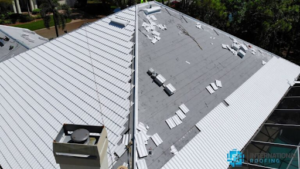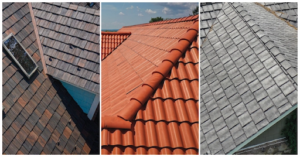Saving energy and reducing utility bills is something everyone wants to do. When building a new home, the exterior envelope of your home presents the greatest opportunity to achieve these goals, and your roof is the first layer of protection to consider. A poorly designed roof can allow excess heat into the attic, causing stress on your AC system, while limiting the comfort level in your home. It can also increase the amount of your utility bills and annual equipment maintenance.
Building your home with a “Cool Roof” can eliminate many of the negative effects of the Sun’s damaging heat and UV rays, and will help you contribute to a cleaner environment.

What Is a “Cool Roof”?
For those living in California, a “cool roof” is part of Title 24 energy requirements and includes a strict adherence to material usage and the reflective quality of the roofing tiles. Generally speaking, a cool roof is a system designed to deliver maximum solar reflectance (reducing the negative effects of ultraviolet rays) and to radiate back to the atmosphere any absorbed heat from the Sun. For non-California residents, there are ENERGY STAR requirements for cool roofing products.
Why Is a Cool Roof Important?
Most roofs in this country are dark, and a black roof on a hot day can reach temperatures above 150° F. This increase in the temperature of your roof can damage your shingles and the decking below. In addition, a hot roof can: Increase the maintenance cost of your home cooling equipment Contribute to the peak electricity demand on your local utility company Make your home a “heat island”, which is a form of urban pollution
Net Zero Energy Efficient Home
A net zero energy home begins with a smart design that consumes as little energy as possible, so the house can produce enough energy to support itself without outside resources. A well-designed cool roof is a step in that direction. Working in conjunction with the insulation package, the cool roof will further reduce the heat introduced to your home, resulting in lower energy requirements.
7 Steps to Designing a Cool Roof
1. Determine Heat Zone
California has its own heat zones, but this article refers to the 7 climate zones recognized by the IECC in the continental U.S. If you live in Zones 6-7, you may not need a cool roof, but having one would not be a disadvantage. Cool roofs are recommended for Zones 1 through 5.
2. Consider Roofing Angle
Roof slopes are divided into two groups: low slope and high slope. A low-slope has a pitch of 2:12 or less. A high slope has a pitch of 3:12 or greater. Low slope roofs are generally covered with single-ply built-up roofing membranes, roof coatings, or metal roofing. High slope roofs can be covered with shingles, tiles, natural products such as slate and terracotta, synthetic composite tiles, as well as the low slope coverings. There are different requirements for solar reflectance between low and high slope roofs, and you need to ensure that the material you are using meets the minimum standards. You can find the requirements here.
3. Understand Weight of Roofing Materials
Whether you use standard roofing construction or you will need additional engineering, depends on the weight of the roofing material you have chosen. Asphalt shingles, singly ply membranes, and metal and synthetic composite roof tiles will not require additional roof support. Terracotta, concrete, and slate will require special engineering, as they weigh more than twice that of standard roofing materials.
4. Use a Radiant Heat Barrier
Title 24 recommends a radiant barrier roof decking be used below all cool roofing materials. This can either be an OSB product with the radiant barrier installed on it, or you can install a stand-alone radiant barrier below the roof decking. This product helps radiate the heat away from the living area and back to the exterior of the home.
5. Choose Roof Tile Materials
Many of today’s roofing products can be made to comply with cool roof requirements, but there are pros and cons associated with each of them. For low pitch roofs, there are elastomeric coatings approved for cool roofs. For high pitch roofs, there are many options. Asphalt shingles are the cheapest, but have the shortest, usable life. Metal roofing can be used but is more expensive than asphalt. Some natural roofing tiles can be modified to meet ENERGY STAR requirements by coating them with the right reflective material - but they are expensive to purchase, install, and maintain.
6. Meet All Code Approval Requirements
The materials used in your cool roof design must meet the requirements of Title 24 for California or the ENERGY STAR requirements of the government. They are product specific and include measurements such as: Initial solar reflectance Maintenance solar reflectance Reliability Thermal emittance Color family group Make sure you look for the ENERGY STAR label or Title 24 label to ensure you have made the correct choice.
7. Abide by HOA Regulations
Even though your HOA won’t have a say in determining if your roof meets the Title 24 or ENERGY STAR specifications, they may have a say in your choice of color or roof tile design. Advanced planning can keep you from having to change design plans if you’ve picked a color or style the HOA won’t agree to.
Using White or Light Tiles for Added Cool

Technology has improved the design of today’s shingles, so there are many color options available to the homeowner building a cool roof. White and light colors are natural reflectors of the sun’s rays, which deliver the heat to your roof, so choose them if you can.
Composite Roofing for a Cool Roof Design

Brava Cool Roof and Title 24 tiles are lightweight and have enhanced solar reflectance and thermal emittance properties, making them a superior choice for your energy-efficient roof design. Our roofing materials have been proven reliable, and come with a 50-year limited warranty. Our products have a Class 4 impact rating, and are available in both a Class C and a Class A fire rating. Brava has 4 cool roof options that meet California’s Title 24 specifications, and our Spanish Barrel Tile Class C is the only white composite tile on the market. Contact us today for free samples of any of our synthetic composite shingles.



